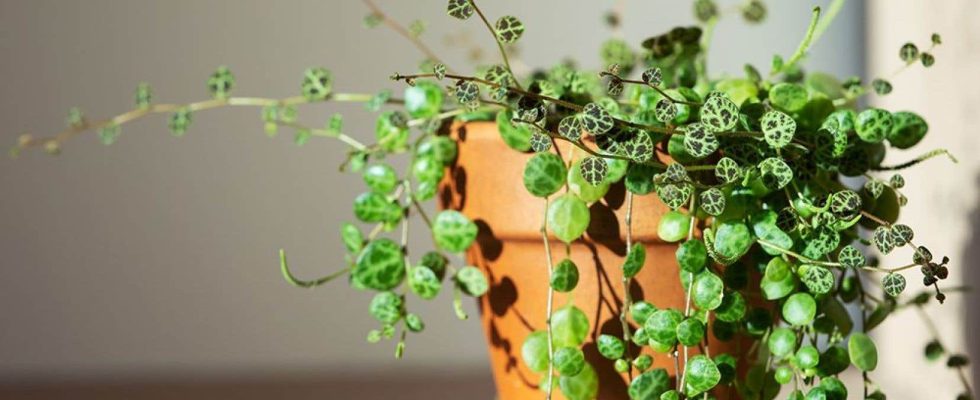This text is part of the special Pleasures notebook
The irresistible charm of these (small) treasures illuminates our living spaces. Whether you are a young city dweller in search of greenery, an inveterate collector or a dean of gardening, mini plants will make you smile instantly. Get ready to personalize your natural oasis — or give gifts that make you happy — with our suggestions for captivating plants in micro format.
1. Turtle Chain (“Peperomia prostrata»): the one that brings your space to life!
Join the wave of Instagrammers by discovering the splendid Peperomia prostrata. This plant, a member of the large Piperaceae family, combines the appearance of succulents with that of tropicals. Its variegated leaves evoke the scales of a turtle: a true plant masterpiece.
Let your creativity run wild: hang it for an airy effect or integrate it into an arrangement so that it gently hangs in front of the container. Its robustness allows it to coexist without worry with other species of the same genus.
Its maintenance is child’s play! Wait for the soil to dry slightly before watering it thoroughly. A little regular pruning session will keep it in a more compact pot and promote a cascade of lush stems. This plant tolerates both bright locations and direct sunlight. However, avoid sticking it too close to a south-facing window.
2. “Monstera minima ‘Swiss Cheese’»: the magnificent in compact format!
Plant lovers, even if your space is limited, know that you can still bring the magic of the Monstera into your home! No more giant pots, Monstera minima also thrives in mini containers!
Like Swiss cheese, each sheet is perforated with strange holes in a very original way. Native to tropical forests, this mesmerizing plant requires continuous maintenance. Let the soil dry slightly, then water thoroughly. You will notice aerial roots: mist them regularly.
For sustained progress, give it a balanced fertilizer in spring and summer. To keep its appearance compact, prune new shoots frequently by pinching them. Avoid direct sun, but make sure your plant still receives good light.
Trick
For structured growth, a tutor (several options are available from your local merchants) will be your ally. Additionally, don’t hesitate to cut off any stems that aren’t going in the direction you want.
3. “Fittonia verschaffeltii» : the mini that demands your attention
Be warned: this beauty demands your full attention! If you’re up for the challenge, the fittonia is sure to enhance your decor. With its leaves in striking contrasts (whether white, red or pink), it will bring a touch of shine that will reward all your efforts.
The main difficulty with fittonia lies in its insatiable need for humidity, at a rate varying between 70 and 90%. You will need to provide it with the humidity it requires… otherwise the leaves will wilt quickly, and your plant will die if you don’t react quickly enough. You might think that a light drizzle would be enough, but the best solution is to make a terrarium or install a glass dome over the plant to keep the humidity at its optimal level. Additionally, regular watering is essential.
In its natural environment, fittonia grows under large trees; it tolerates a little shade very well. To keep this exquisite plant growing, it is recommended to use fertilizer from spring to fall. Ideally opt for a fertilizer based on algae to minimize the risk of root burns.
4. ‘Callisia rempent’ ‘Pink Lady’ and ‘Callisia repens’ ‘Bianca’: easy-care roommates!
Imagine a plant that embodies the elegance of an evening dress, with its captivating white and pink leaves. Welcome to the vibrant world of callisias ‘Pink Lady’ and ‘Bianca’. This creeping plant is ready to brighten up any corner of your home, whatever the light.
This is a species that tolerates aridity. So don’t panic when you let it dry completely. However, for lush growth, choose a place with moderate humidity such as a bathroom.
When it comes to fertilizing, go easy and use about a quarter of the recommended amount. This plant doesn’t need much help to thrive and could suffer from excess nutrients. In winter, reduce the frequency of fertilizer to once a month.
Trick
If you want to maintain its miniature and full appearance, consider pruning it regularly.
This content was produced by the Special Publications team at Duty, relating to marketing. The writing of the Duty did not take part.
